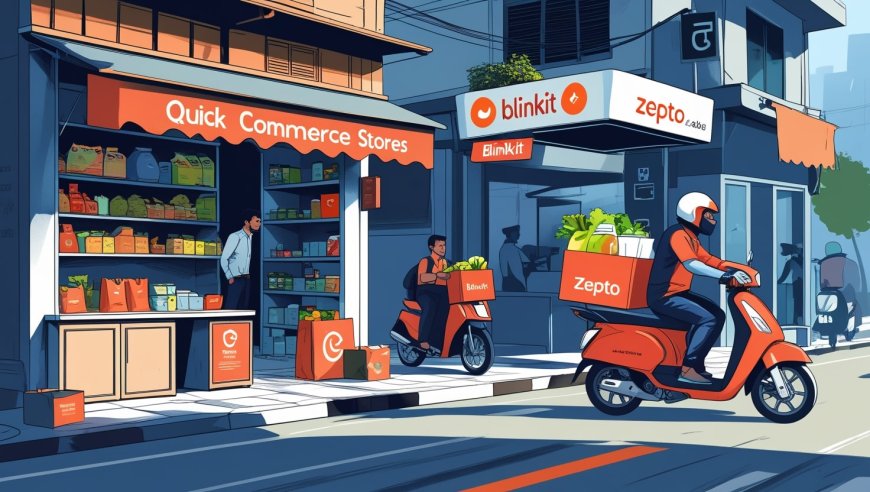The Decline of Kirana Stores Amid the Rise of Quick Commerce in India
An in-depth analysis of how the surge in quick commerce platforms like Blinkit and Zepto has led to the closure of over two lakh traditional kirana stores in India, examining the factors contributing to this shift and its implications on small retailers.

In recent years, India's retail landscape has undergone a significant transformation. The rapid proliferation of quick commerce platforms, promising ultra-fast deliveries, has reshaped consumer expectations and purchasing habits. However, this convenience comes at a cost. Traditional kirana stores, once the backbone of Indian retail, are facing unprecedented challenges. A recent study by the All-India Consumer Products Distributors Federation (AICPDF) revealed that over two lakh (200,000) kirana stores have shuttered in the past year alone, primarily due to the burgeoning presence of quick commerce giants like Blinkit and Zepto.
The Rise of Quick Commerce
Quick commerce refers to the rapid delivery of goods, often within 10 to 30 minutes of ordering. This model has gained immense popularity in urban India, catering to consumers' growing demand for speed and convenience. Platforms such as Blinkit, Zepto, and Swiggy Instamart have capitalized on this trend, establishing extensive networks of dark stores—localized warehouses designed for swift order fulfillment. The quick commerce sector, valued at $3 billion in 2023, is projected to escalate to $40 billion by the end of the decade.
Impact on Kirana Stores
The traditional kirana store has long been a staple in Indian communities, offering personalized service and credit facilities to loyal customers. However, the advent of quick commerce has disrupted this dynamic. The AICPDF study highlights several key impacts:
-
Decline in Foot Traffic: As consumers increasingly opt for the convenience of home deliveries, footfall in kirana stores has diminished significantly.
-
Eroding Profit Margins: Quick commerce platforms often employ aggressive pricing strategies, offering deep discounts that traditional kirana stores struggle to match. This practice, sometimes viewed as predatory pricing, has eroded the customer base and profitability of these small retailers.
-
Operational Challenges: Approximately 65% of kirana stores operate from rented premises. With declining sales and rising rental costs, many find it challenging to sustain operations.
Geographical Distribution of Closures
The impact of quick commerce is not uniform across the country. The AICPDF study provides a breakdown of store closures:
-
Metropolitan Areas: Home to 1.7 million stores with average monthly sales of ₹5.5 lakh, metros account for 45% of the closures.
-
Tier 1 Cities: With 1.2 million stores averaging ₹3.5 lakh in monthly sales, these cities represent 30% of the shutdowns.
-
Tier 2 and 3 Cities: Collectively housing 10 million stores with average monthly sales of ₹2.5 lakh, these areas account for 25% of the closures.
Industry and Government Response
The alarming rate of kirana store closures has prompted calls for intervention. The AICPDF has urged the government to address the challenges posed by quick commerce platforms. They allege that these companies engage in unfair practices, such as selling below cost to attract customers, thereby creating an uneven playing field. The federation plans to submit its findings to the Finance Ministry and the Ministry of Commerce and Industry, seeking measures to protect small retailers.
The Competition Commission of India (CCI) is also scrutinizing e-commerce players for alleged antitrust violations, including preferential treatment of select sellers and predatory pricing. Finance Minister Nirmala Sitharaman has acknowledged the issue, stating that the government will "give a serious thought" to safeguarding the interests of traders affected by such practices.
Consumer Behavior Shifts
The success of quick commerce platforms is largely driven by changing consumer behaviors. A report by NIQ indicates that quick commerce has become the primary shopping method for 31% of urban Indians, with 39% using it for supplementary purchases. Popular categories include ready-to-eat meals, groceries, and snacks. Factors such as speed, convenience, and discounts are significant drivers of this shift.
Challenges for Quick Commerce Platforms
While quick commerce platforms are experiencing rapid growth, they face their own set of challenges:
-
Profitability Concerns: The model relies on high operational costs, including maintaining dark stores and a fleet of delivery personnel. Many platforms operate at a loss, raising questions about the sustainability of their business models.
-
Quality Control: As these platforms scale, maintaining the quality of products, especially perishables like fresh produce, becomes challenging. Consumer dissatisfaction with product quality can erode trust and loyalty.
-
Regulatory Scrutiny: With increasing allegations of unfair practices, quick commerce platforms are under the lens of regulatory bodies, which could lead to stricter regulations impacting their operations.
The Road Ahead
The retail landscape in India is at a crossroads. While quick commerce offers undeniable convenience, the decline of kirana stores raises concerns about the socio-economic fabric of communities. These traditional stores not only provide goods but also foster personal relationships and support local economies.
A balanced approach is essential. Quick commerce platforms could explore partnerships with kirana stores, integrating them into their delivery networks to leverage their local presence and trust. Such collaborations could create a symbiotic relationship, allowing both entities to thrive.
Additionally, policy interventions that ensure fair competition and support for small retailers can help maintain diversity in the retail sector.
Sources : ndtvprofit.com, ft.com

